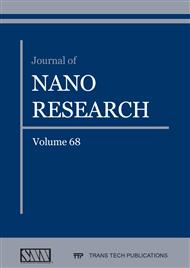[1]
J.H. Fendler, Nanoparticles and nanostructured films: preparation, characterization, and applications, John Wiley & Son, Potsdam, USA, (1998).
Google Scholar
[2]
T.S. Wong, U. Schwane berg, Protein engineering in bioelectric catalysis, Current Opinion in Biotechnology, 14(6) (2003) 590–596.
Google Scholar
[3]
P. Kaur, R. Thakur, A. Chaudhury, Biogenesis of copper nanoparticles using peel extract of Punica granatum and their antimicrobial activity against opportunistic pathogens, J Green Chem Lett Rev. 9 (2016) 33–38.
DOI: 10.1080/17518253.2016.1141238
Google Scholar
[4]
Y. Mu, X. Jiang, Z. Ai, F. Jia, and L. Zhang, Mn2+ promoted Cr (VI) reduction with oxalic acid: the indispensable role of In-situ generated Mn3+, J. Hazard Mater, 343 (2018) 356–363.
DOI: 10.1016/j.jhazmat.2017.10.008
Google Scholar
[5]
X. Hou, X. Huang, F. Jia., Z. Ai, J. Zhao and L. Zhang, Hydroxylamine promoted goethite surface fenton degradation of organic pollutants, Environ Sci. Technol. 51 (2017) 5118–5126.
DOI: 10.1021/acs.est.6b05906
Google Scholar
[6]
H. Li, J. Shang, Z. Yang, W. Shen, Z. Ai and L. Zhang, Oxygen vacancy associated surface fenton chemistry: surface structure dependent hydroxyl radicals generation and substrate dependent reactivity, Environ Sci. Technol. 51 (2017) 5685–5694.
DOI: 10.1021/acs.est.7b00040
Google Scholar
[7]
Y. Mu, Z. Ai, and L. Zhang, Phosphate shifted oxygen reduction pathway on Fe@Fe2o3 core–shell nanowires for enhanced reactive oxygen species generation and aerobic 4-chlorophenol degradation, Environ Sci. Technol. 51 (2017) 8101–8109.
DOI: 10.1021/acs.est.7b01896
Google Scholar
[8]
N. Chen, Y. Huang, X. Hou, Z. Ai and L. Zhang, Photochemistry of hydrochar: reactive oxygen species generation and sulfadimidine degradation, Environ Sci. Technol. 51 (2017) 11278–11287.
DOI: 10.1021/acs.est.7b02740
Google Scholar
[9]
X. Hou, X. Huang, Z. Ai, J. Zhao, & L. Zhang, Ascorbic acid-induced atrazine degradation, Journal of Hazardous Materials, 327 (2017) 71–78.
DOI: 10.1016/j.jhazmat.2016.12.048
Google Scholar
[10]
X. Hou, X. Huang, Z. Ai, J. Zhao and L. Zhang, Ascorbic acid/Fe@Fe2O3: a highly efficient combined Fenton reagent to remove organic contaminants, J. Hazard Mater, 310 (2016) 170–178.
DOI: 10.1016/j.jhazmat.2016.01.020
Google Scholar
[11]
Y. Huang, X. Hou, F. Song, J. Zhao and L. Zhang, Facet-dependent Cr(VI) adsorption of hematite nanocrystals, Environ Sci. Technol. 50 (2016) 1964–(1972).
DOI: 10.1021/acs.est.5b05111
Google Scholar
[12]
L. Wang, M. Cao, Z. Ai and L. Zhang, Design of a highly efficient and wide pH electro-Fenton oxidation system with molecular oxygen activated by ferrous–tetra polyphosphate complex, Environ Sci. Technol. 49 (2016) 3032–3039.
DOI: 10.1021/es505984y
Google Scholar
[13]
Y. Qin, F. Song, Z. Ai, P. Zhang, and L. Zhang, Protocatechuic acid promoted alachlor degradation in Fe(III)/H2O2 Fenton system, Environ Sci. Technol. 49 (2015) 7948–7956.
DOI: 10.1021/es506110w
Google Scholar
[14]
X. Ding, K. Zhao, and L. Zhang, Enhanced photocatalytic removal of sodium Penta chlorophenate with self-doped Bi2WO6 under visible light by generating more superoxide ions, Environ Sci. Technol. 48 (2014) 5823–5831.
DOI: 10.1021/es405714q
Google Scholar
[15]
D. Li, Y. Zhang, Y. Zhang, X. Zhou and S. Guo, Fabrication of bidirectionally doped𝛽-Bi2O3/TiO2-NTs with enhanced photocatalysis under visible light irradiation, J. Hazard Mater (258–259) (2013) 42–49.
DOI: 10.1016/j.jhazmat.2013.02.058
Google Scholar
[16]
S. Ge and L. Zhang, Efficient visible light driven photocatalytic removal of RhB and NO with low temperature synthesized In(OH)x Syhollow nano cubes: a comparative study, Environ Sci. Technol. 45 (2011) 3027–3033.
DOI: 10.1021/es103773g
Google Scholar
[17]
H. Barabadi, M. Ovais, Z.K. Shin wari, M. Saravanan, Anti-cancer green bionanomaterials: present status and future prospects, Green Chem. Lett. Rev. 10 (2017) 285–314.
DOI: 10.1080/17518253.2017.1385856
Google Scholar
[18]
R. Emmanuel, M. Saravanan, M. Ovais, S. Padmavathy, Z.K. Shinwari, P. Prakash, Antimicrobial efficacy of drug blended biosynthesized colloidal gold nanoparticles from Justicia glauca against oral pathogens: a nano antibiotic approach, Microb. Pathog. 113 (2017) 295–302.
DOI: 10.1016/j.micpath.2017.10.055
Google Scholar
[19]
R.M. Jose, C.L. Jose, E. Alejandra, H .Katherine, B.K. Juan, R. Jose Tapia and Y. Miguel Jose, The bactericidal effect of silver nanoparticles, Nano technol, 16 (2005) 2346-2353.
Google Scholar
[20]
R. Pacios, R. Marcilla, C. Pozo-Gonzalo, J.A. Pomposo, H. Grande, J. Aizpurua, and D. Mecerreyes, Combined Electrochromic and Plasmonic Optical Responses in Conducting Polymer/Metal Nanoparticle Films, Journal of Nanoscience and Nanotechnology, 7(8) (2007) 2938–2941.
DOI: 10.1166/jnn.2007.623
Google Scholar
[21]
P. Singh, Y-J.Kim, D. Zhang, and D-C.Yang, Biological synthesis of nanoparticles from plants and microorganisms, Trends Biotechnol. 34 (2016) 588–599.
DOI: 10.1016/j.tibtech.2016.02.006
Google Scholar
[22]
B. Pooja, S.D. Joginder, and K. G. Suresh, Biogenesis of nanoparticles: A review, African Journal of Biotechnology, 13(28) (2014) 2778–2785.
DOI: 10.5897/ajb2013.13458
Google Scholar
[23]
D.R. Lovley, J.F. Stolz, G.L. Nord and E.J.P. Phillips, Anaerobic production of magnetite by a dissimilatory iron-reducing microorganism, Nature, 330(6145) (1987) 252–254.
DOI: 10.1038/330252a0
Google Scholar
[24]
D. P. Dickson, Nanostructured magnetism in living systems, Journal of Magnetism and Magnetic Materials, 203(1-3) (1999) 46–49.
DOI: 10.1016/s0304-8853(99)00178-x
Google Scholar
[25]
T. Klaus-Joerger, R. Joerger, E. Olsson, and C.-G. Granqvist, Bacteria as workers in the living factory: metal-accumulating bacteria and their potential for materials science, Trends in Biotechnology, 19(1) (2001) 15–20.
DOI: 10.1016/s0167-7799(00)01514-6
Google Scholar
[26]
N.I. Hulkoti, T. Taranath, Biosynthesis of nanoparticles using microbes—A review, Colloids Surf. B. 121 (2014) 474–483.
DOI: 10.1016/j.colsurfb.2014.05.027
Google Scholar
[27]
J. G. Holt, Bergey's manual of determinative bacteriology, ninth ed., Williams and Wilkins, Baltimore, M.A. (1994).
Google Scholar
[28]
J. Michael Janda, L. Sharon, Abbott, 16s rRNA gene sequencing for bacterial identification in the diagnostic laboratory: Pluses, Perils, and Pitfalls, 45(9) (2007) 2761-2764.
DOI: 10.1128/jcm.01228-07
Google Scholar
[29]
I. Lobo, Basic Local Alignment Search Tool (BLAST), Nature Education, 1(1) (2008) 215.
Google Scholar
[30]
A. Ahmad, P. Mukherjee, S. Senapati, D. Mandal, M. I. Khan, R. Kumar, and M. Sastry, Extracellular biosynthesis of silver nanoparticles using the fungus Fusarium oxysporum, Colloids and Surfaces B: Biointerfaces, 28(4) (2003) 313-318.
DOI: 10.1016/s0927-7765(02)00174-1
Google Scholar
[31]
P. Chowdappa, G. Shivakumar, Nanotechnology in crop protection: status and cope, PestManagHorticEcosys 19 (2013) 131–151.
Google Scholar
[32]
S. Gurunathan, K. Kalishwaralal, R. Vaidyanathan, D. Venkataraman, S. R. K. Pandian, J. Muniyandi, S. H. Eom, Biosynthesis, purification and characterization of silver nanoparticles using Escherichia coli, Colloids and Surfaces B: Biointerfaces, 74(1) (2009) 328–335.
DOI: 10.1016/j.colsurfb.2009.07.048
Google Scholar


